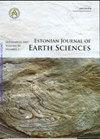瑞典Tingskullen岩心庙岭期(寒武系)三叶虫生物地层学与碳同位素化学地层学研究Öland
IF 0.8
4区 地球科学
Q4 GEOSCIENCES, MULTIDISCIPLINARY
引用次数: 2
摘要
Öland北部的亭skullen岩心寒武系由寒武系二系和庙岭期(五流期)硅屑层组成。以苗岭期Borgholm组为代表,该组依次分为Mossberga组、ba本文章由计算机程序翻译,如有差异,请以英文原文为准。
Miaolingian (Cambrian) trilobite biostratigraphy and carbon isotope chemostratigraphy in the Tingskullen drill core, Öland, Sweden
The Cambrian succession of the Tingskullen drill core from northern Öland comprises Cambrian Series 2 and Miaolingian (Wuliuan Stage) siliciclastic strata. The major portion of the succession is represented by the Miaolingian Borgholm Formation, which, in ascending order, is subdivided into the Mossberga, Bårstad and Äleklinta members. The Äleklinta Member is barren of body fossils, whereas the Mossberga and Bårstad members are moderately to highly fossiliferous and biostratigraphically reasonably well constrained. Trilobites and agnostoids from the Bårstad Member are indicative of the Acadoparadoxides pinus Zone. The Mossberga Member has not yielded any zonal guide fossils but is tentatively assigned to the Eccaparadoxides insularis Zone. A δCorg curve throughout the Borgholm Formation shows a general positive trend upsection without any distinctive excursion, suggesting that the Wuliuan Acadoparadoxides (Baltoparadoxides) oelandicus Superzone (the ‘Oelandicus beds’) of Öland is younger than the negative Redlichiid–Olenellid Extinction Carbon isotope Excursion (ROECE), which is known from near the top of Stage 4 and close to the traditional ‘Lower–Middle Cambrian boundary’ in several parts of the world.
求助全文
通过发布文献求助,成功后即可免费获取论文全文。
去求助
来源期刊

Estonian Journal of Earth Sciences
地学-地球科学综合
CiteScore
1.50
自引率
9.10%
发文量
11
审稿时长
>12 weeks
期刊介绍:
The Estonian Journal of Earth Sciences is an international scientific open access journal published by the Estonian Academy of Sciences in collaboration with the Tallinn University of Technology, the University of Tartu, the Estonian University of Life Sciences and the Talllinn University.
The journal publishes primary research and review papers in the English language. All articles are provided with short Estonian summaries.
All papers to be published in the journal are peer reviewed internationally.
The journal is open for publications in all fields of Earth sciences, including besides different geological sensu lato disciplines, also geography and oceanography having certain connection with our part of the world, North Europe and the Baltic area in particular.
 求助内容:
求助内容: 应助结果提醒方式:
应助结果提醒方式:


